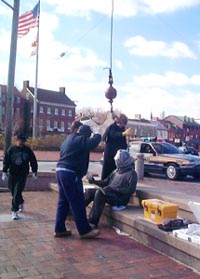 Baby Boom
Baby BoomAlex Haley and Company Add Four to Annapolis' Family of Public Statues
by M.L. Faunce, Sam Ginder, Christy Grimes and Sandra Martin
 Baby Boom
Baby Boom
Alex Haley and Company Add Four
to Annapolis' Family of Public Statues
by M.L. Faunce, Sam Ginder, Christy Grimes
and Sandra Martin
Visit, with us, the whole family, young and old ...
Alex Haley - who's been dead for seven years - and three young friends took up permanent residence in Annapolis this week. They've been on their way here for 20 years. That mere two decades will pale to insignificance in comparison to the time they'll be with us. For the new arrivals are statues, come to stay for the unforeseeable future. So the city and its newest citizens will have all the time in the world to get to know each other.
Preparing for these newcomers in the weeks before their Dec. 9 unveiling opened our eyes to our capital city's existing family of statues. It isn't a very large family. Unlike the District of Columbia and many other state capitals, Annapolis has not turned to statues to commemorate its shared triumphs, salve our losses or uplift the spirits of the living. Alex Haley and company account for as many as have joined the family in the past 75 years.
The exception, of course, is the Thurgood Marshall group that's made its home on Lawyers Mall since 1996. In a grouping to which the Haley group makes reference, the young and very modern Marshall standing alone on a granite pedestal looks out on three watching children. They are three of the children who, with him, ended school segregation at the University of Maryland and in the nation.
Until this week, the Marshall group has been the youngest of statuary family that is a lot like human families. Among our small family of statues, we've got warring siblings, achievers, respected elders, forgotten ancestors and neglected children - plus a few batty aunts and uncles in the attic. As in any human family, the worst fate that can befall a member is to be ignored. By this measure, the Haley monument is off to a good start. But the future is a long, long time.
Long after the fashions of the late 20th century seem as archaic as wigs and togas, when the vision behind the name Alex Haley is forgotten, will these four statues inspire and educate as the people who, in the mid-1990s planned them, envisioned? Or will they seem as out of date to our grandchildren's children as the Revolutionary War and World War I memorials that stand ignored and irrelevant on the campus of St. John's College?
Those are the kinds of questions you think about when you visit Annapolis' growing family of public statues.
Cast in Bronze, Set in Controversy
You might think public art is supposed to inspire and uplift - not enrage. But controversy at least means somebody is paying attention. The 127-year-old statue of former U.S. Supreme Court Justice Roger Brooke Taney, on the front lawn of the Maryland State House, drew little enough attention for decades.
But in the 1990s, some folks who knew their history paid enough attention to openly wonder why a statue of a man who was - at least in effect - a racist inhabited State House grounds. Taney, whose bronze image sits cloaked in judicial robes moldering with tarnish, ruled in the Dred Scott case the U.S. Government couldn't forbid slavery, couldn't free slaves, and that it was even okay to own slaves anywhere. This despite the Missouri Compromise, which declared certain states "free."
Instead of lobbying to lift Taney, the Legislative Black Caucus forged its own compromise: Let the berobed former U.S. Chief Justice continue to squat on one side of State Circle. A memorial need not evoke the positive, the Caucus decided, and Taney would at least remind people of a time when the Dred Scott decision was considered justice. But it should be balanced with a symbol of progress. From these beginnings sprang the nearby Thurgood Marshall Memorial, dedicated to the first African American Supreme Court justice and one of the great figures in civil rights history.
The sculptures of the two Maryland jurists who served on the U.S. Supreme Court a century apart from one another - and who were a spectrum apart in philosophy - flank opposite sides of the State House. Taney occupies his bench above the Capitol steps facing east, while beyond the west steps in the center of Lawyers Mall Thurgood Marshall stands tall for equal justice.
Funded by the 1993 General Assembly, the grouping evolved from a national design competition drawing 120 hopeful sculptors. Boonsboro, Maryland artist Antonio Tobias Mendez submitted the winning design: a group of bronze figures representing the landmark Brown vs. Board of Education case Marshall won to end racial segregation in U.S. public schools. The group of bronze figures depicts Justice Marshall as a young lawyer, on a granite pedestal presiding over two children seated on a nearby granite bench.
Nearby sits the figure of Donald Gaines Murray, symbol of Marshall's landmark victory in Murray vs. University of Maryland, which integrated the university.
The setting, a small public square planted with crabapple trees, is formal but intimate enough for private, casual conversation. Visitors and lunching office workers often share the bench with the two seated bronze children.
People are Mendez's specialty. In action, repose, or in deepest thought, the sculptor treats us to art that imitates life, that symbolizes what we believe life can mean, and what we recognize and appreciate as real in our lives. His lasting values have staying power, and we are happy to stay with them, even if we are just strolling by.
The Thurgood Marshall Memorial was born because somebody noticed Roger Brooke Taney. Now Marshall and Taney control opposite ends of our State Capitol, as they did opposite ends of our philosophical spectrum. The pair stand and sit as testimony to what can happen when you look at the statues sharing your city space.
Lively Traditions of Naval History
It's easier for a statue to get attention if it's fresh and innovative, like the Thurgood Memorial, or just scandalous, like the Taney Statue. But you can always guarantee interest by enforcing it.
At the U.S. Naval Academy mess hall, an upperclassman might ask a plebe, "Mister, who are Shubrick, Pillsbury, Clemson and Hynson, and what are they famous for?" A plebe who hasn't studied the "Reef Points" - the plebe handbook of must-know information - probably won't know the answer. Which means looking forward to "coming around" to the upperclassman's room for some harsh extra instruction. Or perhaps finishing dinner under the table.
The names of these four midshipmen are inscribed in a wreath on the marble
face of the 1848 Mexican War monument, the Academy's first memorial sculpture.
Though not Academy midshipmen, the four were beloved by their Academy peers.
Thus the Mexican War Monument has remained relevant for a century and a
half.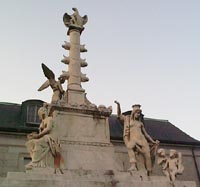
Midshipmen had also better know the history of one of the nation's oldest outdoor monuments, the Tripoli Monument, and the six officers killed in 1804 during the war against Barbary pirates. Requiring midshipmen to have these facts in the forefront of their minds is no mere pedantic exercise. The casualties these plebes are asked to remember form a chain of history in which they'll soon be links.
Some statues on Academy grounds play more active roles in community life as objects of ritual. Take Chief Tecumseh, just outside Bancroft Hall. Revered less as a legendary Shawnee warrior than as the Patron Saint of Passing Grades, he is supplicated with a left-hand salute to ensure success on exams. Known as the God of 2.5 (minimum passing grade of old), Tecumseh is pelted with pennies in hopes of a good grade. A penny landing in the chief's quiver of arrows bodes especially well.
Replica of the navy ship Delaware's figurehead, the Chief Tecumseh monument is actually a likeness of Tamanend, that peaceful chief of the Delaware Indians who befriended the early colonial settlers. But the midshipmen never called the Indian by his true name. They called him Powhatan, King Philip and at one time 'Old Sebree' (for a supposed resemblance to midshipman Uriel Sebree, class of 1867) - but never Tamanend. Eventually, midshipmen settled on Tecumseh, terror of the American frontier during the War of 1812. A war chief seemed to suit their fancy more than a peaceful figure.
In 1930, the Academy copied the original wood figurehead in bronze for outside display in Tecumseh Court across from Bancroft Hall. The original wooden figurehead is displayed in the Naval Academy Visitors' Center. The bronze replica contains fragments of the original, to ensure that the midshipmen's customs will continue to bring luck.
The ceremony involving the Herndon monument is known far beyond Academy walls. An entire class of plebes scrambling up the greased 21-foot-high obelisk to retrieve an upperclassman's cap serves as an Annapolis rite of spring. For the plebes, it is the final indignity of the ordeal that is plebe year. Only when, after four or six hours of struggle, a thoroughly greased mid gets hold of the cap and dons it for all to see, is plebe year officially over for this class. By Academy myth, the mid who gets the cap is destined to become that class's first admiral. Accordingly, the academy superintendent gives the triumphant plebe admiral's shoulder boards.
Midshipmen even find ways to involve their monuments in sporting events. In Bancroft Hall court stands the Japanese Bell, dating from 1456. Nearby is the ship's bell from the fabled World War II aircraft carrier Enterprise. The Brigade of Midshipmen rings both to celebrate football victories over Army.
The Academy's most elaborate monument, The Tripoli, also ranks among the nation's oldest. Created in 1806, time and the elements are wearing down the Tripoli's exquisite detail. The Academy's maintenance budget can't cover most of the restoration and care the Tripoli needs. A baroque display of classical female figures around an ornate central column, atop which an eagle grandly perches, the Tripoli needs your help to salvage its splendor. Your tax deductible contribution can be made by check to the Naval Academy Alumni Association, designating Tripoli Monument on the check. Send to: The Naval Academy Alumni Association, 247 King George St., Annapolis, MD 21402 · 410/263-4448.
Monuments? What Monuments?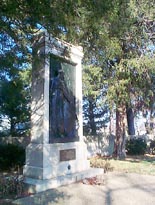
By mandatory practice or arcane ritual, the U.S. Naval Academy's monuments retain vitality and relevance. But at neighboring St. John's, the two war memorials book-ending campus might as well be absent. Without its beloved Liberty Tree, St. John's suddenly looks a little bald. Were its World War I or French Memorial to vanish as abruptly, would anyone notice? Ask a St. John's student about either of these works and the average response is: "Huh? Oh, those."
It wasn't always so: The Washington, Baltimore and Annapolis electric rail transported all 260 pounds of President William Howard Taft to the French Monument's 1911 unveiling, an all-day gala of speeches, drills and parties that got three days of local headline coverage.
The monument is dedicated to French soldiers resting beneath St. John's playing fields along College Creek. Troops camped there in 1781 on their way south to help General Washington corner Cornwallis and win our independence. They also stopped on their way back, losing a few brave Frenchmen each way to disease, wounds and the rigors of the march.
At the 1911 dedication, the Evening Capital reported: "Old - very old - Annapolitans can recall their great-great grandfathers speaking of a few simple headstones that marked the graves of some of the French dead buried here."
No one complained when groundskeepers eventually razed the markers while grading the college playing fields. Whoops. So why the sudden interest over a century later?
Answer: the return of John Paul Jones, whose body the French had recently transferred to the Naval Academy after 50 years in a French cemetery. Touched by the care and respect shown one of their heroes, the Navy wished to repay the gesture. But how? Hey, what about those Revolutionary soldiers? Thus was born the world's first known monument to unnamed soldiers.
As you leave town on King George Street, crane your neck just before College Creek bridge and you may glimpse the French Monument. It's worth a look. On a rise overseeing the creek, it invites contemplation and reverence (though it tends to attract butts and bottle caps instead). Cedars and tall pines planted along a low wall partly encircling it shade the monument, a bronze tablet on which a heroic female figure - in such high relief she almost steps off the plaque - brandishes a shield. Behind her, French troops march off to their transports, faintly visible in the background. At her feet sit two humble gravestones, probably like the ones once marking the fallen French.
Just inside St. John's main entrance on College Avenue, the World War I monument is harder to miss. Still, the scant attention it has drawn over the years has been from graffiti-writing vandals. Though no presidents attended its 1920 dedication, the ceremony at least drew newly elected Gov. Albert C. Ritchie.
In those days, St. John's had an officer training corps and sent over 400 men overseas in World War I. Commissioned by St. John's alumni, the monument remembers the 24 students who didn't come back. In bronze bas relief, a woman warrior leans on a shield bearing their names.
After the dedication, interest waned. The monument was never cared for. By 1995, it had degenerated into such an eyesore a concerned alumni group had the work overhauled and rededicated. Restorers blasted the tarnish, dirt and literary contributions from the bronze plaque and its polished limestone and granite shaft with an abrasive of ground walnut shells, then waxed it.
St. John's Liberty Tree was part of campus life. Generations of memories were made in its shade. But for a school that no longer grooms cadets, whose current students have never lived through an actual war, formal slab-and-tablet memorials offer small substitute.
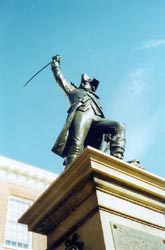 The Corn God
The Corn God
Lately an even more tempting target for vandals has been the sword of Baron de Kalb of Germany. At the State House, where Marshall and Taney ponder each other from the east and west ends, de Kalb takes the south end. From atop a ludicrously high pedestal, he looms over pedestrian traffic. In a tricorn hat and swashbuckler boots, clutching the sword in his upraised arm, the baron is poised for attack. Maybe that's why people keep breaking his sword. Since 1990, it's been broken and repaired twice.
The de Kalb on the statue was a middle-age freelance and all-purpose warrior when he offered his services to the American Revolutionaries. Made a general, he served with Washington at Valley Forge. The legend on the statue's pedestal may explain de Kalb's contorted pose: "Leading on the troops against superior numbers and animating them by his example to deeds of valor he was pierced with many wounds."
Heroic, but in a war full of heroes how does the baron rate as a monument? Some felt he didn't. De Kalb fans lobbied the U.S. government over a century before Grover Cleveland finally approved. Designed by the "dean of Baltimore sculptors" Ephraim Keyser (two of whose students created the St. John's monuments) the piece was dedicated in 1886, a slow time in military history.
So you don't know who de Kalb is, or his derring-do fails to awe you. His flamboyant presentation is at least bound to make an impression. Just spare his sword.
Location Is a Lot
The World War I Memorial at St. John's College stands in plain sight and in your path. But since its idiom no longer speaks to us, we don't notice. At least we can see it. Too bad Hilda Mae Snoops, official Government House hostess during William Donald Schaefer's administrations, couldn't install her glorious fountain there instead of tucking it in the back yard of the Governor's mansion where few even know it exists.
As controversial as Snoops herself at the time she commissioned
it, the sculpted fountain carved with Maryland wildlife motifs outlived
personal criticism of the former lady-in-residence. It now wears the patina,
if not of age, then at least of acceptance and appreciation.
commissioned
it, the sculpted fountain carved with Maryland wildlife motifs outlived
personal criticism of the former lady-in-residence. It now wears the patina,
if not of age, then at least of acceptance and appreciation.
Better still if Snoops could have set her fountain in front of the mansion instead of out back. As you stroll around State Circle, you get a clear view of the front lawn. This inspired current First Lady Frances Glendening to put up a lawn statue display - not pink flamingoes and birdbaths but real art by real sculptors.
Through A Celebration of the Arts in Maryland, Glendening honors Maryland artists. The featured sculptors and their works rotate periodically. Currently you can admire the art of Rodney Carroll and Antonio Tobias Mendez, who brought us the Thurgood Marshall memorial.
"Mrs. Glendening is amazed how many people stop by to look at the statues," said Ann Wallace, special assistant to the First Lady. We want to rotate them so other Maryland artists get a chance."
Adrift in a Sea of Change
Consider the bizarre fate of another fountain within sight and a stone's throw of Hilda Mae Snoops' secret fountain: the Southgate Memorial. A broad basin with a tall, Anglican cross as its centerpiece, the fountain honors the Rev. William Scott Southgate, rector of St. Anne's for 30 years. After Southgate's death, the popular minister was honored by Annapolis citizens of all denominations, particularly African Americans, for his community improvements.
Before his death, Southgate had planned the fountain as his latest community improvement, "for thirsting man and beast." Southgate's congregation fulfilled his wishes in 1901.
Back then the fountain might have provided a cool trickle of water where a pedestrian might have sat on a hot day for a break from the hustle of the old port town. Today it stands marooned on a traffic island where the two circles - State and Church - connect. Vehicular traffic swirls, beasts are few and pedestrians carrying bottled water cling to the long-dry fountain for safety if not refreshment.
New Kids on the Block
Now, everything's changed. There's a new kid - in fact three, plus one adult - in the family of Annapolis sculpture, and it's at them everybody's looking.
The three bronze children gather at the bronze feet of the man whose Roots journey not only turned America into a nation of genealogists but also broke the nation's long silence on slavery. Alex Haley sits on the wall at the head of Annapolis Harbor. African American, European American and Asian American in descent, the kids listen spellbound to the resonant story of how Haley traced his roots to Kunta Kinte. To Annapolis.
In a project 20 years in the making, they were unveiled Dec. 9, 1999 with pomp, ceremony and lots of dignitaries: Gov. Parris Glendening; Sen. Paul Sarbanes; Maryland Senate President Thomas V. Mike Miller and House Speaker Casper Taylor; Anne Arundel County Executive Janet Owens and School Superintendent Carol Parham; Annapolis Mayor Dean Johnson; Haley's nephew Chris Haley, now a Maryland state archivist; and John Amos, the actor who played Kunta Kinte in the television series dramatizing Haley's 1976 novel.
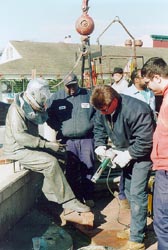 If Roger Brooke Taney and Thurgood
Marshall a few blocks away memorialize our nation's thesis and antithesis
- enslavement and liberation - Annapolis' newest statue grouping is our
synthesis: Reconciliation. At least that's how the man who calls himself
today's "spark plug" in the project, Leonard Blackshear, Annapolis
businessman and president of the Kunta Kinte-Alex Haley Foundation, envisions
it.
If Roger Brooke Taney and Thurgood
Marshall a few blocks away memorialize our nation's thesis and antithesis
- enslavement and liberation - Annapolis' newest statue grouping is our
synthesis: Reconciliation. At least that's how the man who calls himself
today's "spark plug" in the project, Leonard Blackshear, Annapolis
businessman and president of the Kunta Kinte-Alex Haley Foundation, envisions
it.
"Slavery did not begin in Annapolis," Blackshear says. "But reconciliation can begin here."
Alex Haley now dwells at Annapolis City Dock on the very spot where his ancestor Kunta Kinte first set foot on American soil, disembarking after a tortuous three-month passage from Gambia to be sold into slavery.
That story, living in legend for nearly 200 years, sparked Haley's quest. Seeking his deep-buried roots, the storyteller-historian confirmed Annapolis as the slave port where Kunta Kinte had been sold and the Lord Ligonier as the slave ship on which he and 97 other Gambians had traveled in bondage. Retired Maryland state archivist Phebe Jacobsen, of Annapolis, discovered the missing link in the ship's papers and Maryland Gazette advertisement of the slave sale.
"On Wednesday the 7th of October next," read the advertisement from Oct. 1, 1767, "Just Imported in the Ship Lord Ligonier, Capt. Davies, from the River Gambia, in Africa, and to be sold in Annapolis, a Cargo of Choice, Healthy Slaves."
From Gambia to Annapolis and far beyond, blending legend and research, Haley reconstructed Kunta Kinte's history over 10 generations, even unto his own.
As the story of Kunta Kinte took root and blossomed in the minds of people all over the world, so it bloomed in Annapolis.
We are the beginning. We, especially, ought to have a memorial, people said. And thus began the 20-year quest.
Like Kunta Kinte's story, the vision stayed alive, passing from person to person, organization to organization in a long list. Champions came and went, but intention endured.
Over the years, the vision took just as many forms, evolving from a commemorative plaque laid in 1981, to the popular, community-wide Heritage and Kunta Kinte Festivals to education outreach programs for Maryland students. The success of those 1993 "teach-ins" showed "growing, year-round interest," Blackshear said, and revitalized interest in "an Annapolis memorial to the Roots message."
Community meetings voiced three standards for the memorial: it should be near the water; it should tell a story; and the story should be both educational and inspirational. Eighteen sculptors accepted a national bidding invitation, based on Eastport architect Schwerzler's vision and another local man, Jay Kabriel's, design, both integrating sculpture into the street scene of City Dock. From the "maquettes" or small concept pieces submitted by that group, a community committee selected four finalists. A committee of artists chose Ed Dwight, who is an African American as well as a nationally known sculptor. With a couple of modifications suggested by the Historic District Commission, work began.
Meanwhile, fundraising began in earnest. The total cost for the memorial would be $300,000. Of that, public money amounted to about half, with Anne Arundel County donating $100,000, the City of Annapolis $40,000 and the Maryland State Arts Council $10,000. Community donors and the Haley family matched that amount.
By the first days of December, 1999, Dwight was loading the near-960 pounds of bronze on a flatbed truck to travel over mountains, Great Plains, prairies and more mountains to Annapolis. On Dec. 7, four men and a forklift toted and welded them into the sidewalk at City Dock.
"It's not how you started out but how you plan to end up that people look at in America," Blackshear told the citizens and dignitaries crowding around the new, bronze members of the Annapolis family.
"The symbol of how Kunta Kinte ended up is Alex Haley. He made Kunta Kinte an international icon of rising above."
That evolution brought Haley to "Napolis" to stay.
Of course, not everybody's going to welcome Alex Haley as a symbol of reconciliation. Racial equality may be the law of the land, but prejudice runs under the law like a subterranean river.
We've seen the Ku Klux Klan marching on Lawyers Mall, where Thurgood Marshall and his children now reside. The original Kunta Kinte plaque, embedded in 1981 in the sidewalk near where Haley's feet now rest, was wrenched away within 48 hours. The Haley memorial arrived under security.
The spot the memorial now occupies on City Dock has seen much good and evil over the centuries. Now, at least, it is occupied by hope.
Even with the dedication of the new statues, the Kunta Kinte-Alex Haley Memorial is not finished. The third phase will be a story wall along Compromise Street on the theme of reconciliation.
Contributions are welcome. 410/841-6920 www.kintehaley.org
M.L. Faunce wrote on the Thurgood Marshall grouping and de Kalb statue, Sam Ginder on the Naval Academy statues, Christy Grimes on St. John's and Sandra Martin on the Haley Memorial.
Third Graders Discover Haley Roots -
And Their Own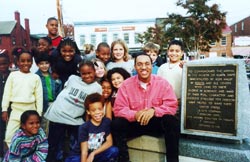
by M.L. Faunce
Annapolis Elementary School third graders got a special introduction to the city's new statues along with a lesson in family history - theirs and Kunta Kinte's. Eight-year-olds being eight years old, they were excited about both.
Sixteen bubbly, jean-clad youngsters joined Chris Haley, nephew of author Alex Haley and descendant of Kunta Kinte, at City Dock for a talk about discovering family roots. As students gathered around Haley, they formed a living replica of the new Haley tableau of life-size statues.
Haley, an actor and screenwriter, got the kids giggling when he asked if they knew what their roots were. "It's about family," he then told them. "You are a generation," Haley explained. "So is your mother and father, and so are your grandparents."
After reading to the kids from Roots, Alex Haley's renowned family album, Chris Haley explained it in their own terms: "When you know all the names in your family, you'll know your family tree - that's what this book is about," he said.
Then he recalled his great-aunt Elizabeth telling the story of his great, great, great, great, great grandfather, Kunta Kinte, who "landed right here at City Dock in 1767." The kids rolled their eyes. So far, dates were not their specialty, and they tried to recall their own parents' birth dates with difficulty.
These third-graders are learning to research their family history as part of a school project to introduce them to the history of Annapolis and figures from their own community. Haley, also a reference associate at Maryland Archives, will help the students write living histories of people they know - and don't yet know - who helped shape Annapolis. The visit was part of a Maryland State Archives outreach to get kids and monuments together.
While Haley read to students, teachers proudly observed youngsters learning that genealogy is just another word for family history, taught by a man intent on passing along the history of his own family, descended from an enslaved African whose name - thanks to Chris Haley's uncle - is now a household word.
The learning experiment "is proof children can understand complex things like fairness and justice," said their principal, Becky Schou.
What did the kids think? "We're learning about history," said Brandon Legg. "We're gonna write a book for moms and dads to share the good times." Shawn Holland giggled, "I learned that if my great, great grandmother didn't get married to a man, I wouldn't be there."
Chris Haley could relate to that. At their age, his image of his Uncle Alex was of a guy who "always gave me a 5-dollar bill, $10 at Christmas, and I'd say, 'Gee, I can buy a boat.'"
| Issue 49 |
Volume VII Number 49
December 9-15, 1999
New Bay Times
| Homepage |
| Back to Archives |